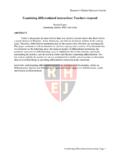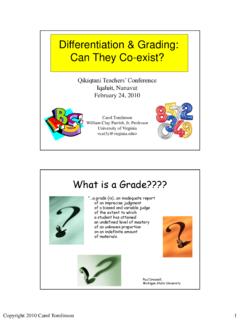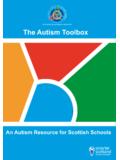Transcription of Section 2: Differentiation in practice in the …
1 Section 2: Differentiation in practice inthe curriculumUsing Differentiation to achieve pace and varietyDifferentiation is about teaching and learning styles and teachers should be using all threetypes of Differentiation in order to have a variety of teaching approaches to accommodatethe different learning styles in the classroom. As has been outlined above, teachers who onlyorganise in the ability group way are limiting the learning of many pupils in their classes,particularly those with special educational needs. All pupils should experience all three typesof Differentiation in order for teachers and pupils to maximise the teaching and learning thatoccurs in the best way to meet pupil s different learning needs is to deliver the curriculum in a numberof different ways; to differentiate the vehicle by which the skills, knowledge and conceptsarrive, as well as presenting a range of tasks.
2 The reason for doing this is because it ensuresthe maximum amount of pupil involvement, ie pupil planning, pupil assessment and pupildecision-making. In fact, the three can be fitted into a logical progression of teach, practiceand assess: Differentiation by classroom organisationis a way of helping pupils to accessknowledge, increase understanding, develop concepts and practise skills Differentiation by paired task is a way of helping pupils to self-assess, peer assess,target set and practise skills to reach targets Differentiation by outcomeis a way of both accessing knowledge and experiencesand assessing at the end of the teach and practise cycle. The key to the differentiated curriculum is the flexible use by teachers of a wide rangeof activities and lesson organisations.
3 Janet Spillman, 1991 Teachers can use any approach to Differentiation and in any order, so long as they getstarted. All the ideas presented in this pack have two purposes: for immediate use in theclassroom and to stimulate activities in this pack provide examples of all three types of Differentiation . By examiningthese ideas, teachers can assess which forms of Differentiation they already use and whichsteps or methods to try next in order to increase their repertoire of curriculum delivery activities centre around the core subjects of English, Mathematics and Science. They areoffered in the format outlined above Differentiation by paired task, outcome and classroomorganisation.
4 In this way, teachers can try out all the approaches and will start to experimentapplying the ideas offered for one part of the curriculum to other An Approach to Teaching and LearningPearson Publishing, Chesterton Mill, French s Road, Cambridge CB4 3NP Tel 01223 35055530 Teacher planningOne of the rules that should be operated is the 80-20 rule. Usually when differentiating bytask in the old way , the teacher does 80% of the work and the pupils do 20%. Look forways of changing that round so that the pupils do 80% of the work and the teacher does20%. This makes teachers less tired; pupils more engaged and less , for example, you want a pupil to do a cloze exercise on the topic you have just finished,rather than writing this yourself get them to devise a cloze exercise on this topic for youngeraged pupils who know nothing about this topic.
5 As well as saving time for the teacher to geton and teach, this method increases motivation, self-esteem and learning for the older all, teachers come to understand their topic better as they teach method of approaching the planning of the curriculum can help to offset the extraplanning and preparation which teachers may feel daunted by when faced with thesuggestions for workshops in Differentiation by outcome, or the skills training indifferentiation by classroom time and effort invested in planning and organisation is well worth it. It means that yourrole as a teacher changes dramatically. Instead of answering questions about pencils,margins, dates and other presentation/getting started issues, you will be either observing andassessing the pupils, or engaged in discussions with the pupils about their the outcomes and criteria with the pupilsIn this pack the outcomes rather than the aims for each activity are identified.
6 This isdeliberate as identifying and sharing the outcomes is a crucial part of Differentiation andeffective teaching. Pupils often know the task but do not understand why they are doing means they cannot show off their learning. A helpful way of doing this is to write onthe whiteboard a description of where the pupils should be and what they should be able todo if they have finished .Proforma 1(page 93) is an example of a planning sheet for teachers. This could then beused as a guide as to what to write on the board for the pupils. It may be that there is onlyone aspect of learning that will be focused on in the lesson; it may be that all four will bevisited it does not matter. What matters is that the teacher prioritises the learning beforechoosing an activity and allows the pupils some choice in arriving at the learning teacher assessment sheet Proforma 2 (page 94) and the assessment form for the pupilsPupil sheet 10(page 86) are two ways in which the teacher can assess the impact on thepupils of the sharing of the learning objectives and the Differentiation of the activities outlined below tend to use the Three-part lesson approach , ie Focus, Do,Review.
7 A 50-minute lesson is assumed in each of the following activities. This may becloser to a double lesson in some schools. If you have 35-minute lessons then do shortermain activities but still use the three-part An Approach to Teaching and LearningPearson Publishing, Chesterton Mill, French s Road, Cambridge CB4 3NP Tel 01223 35055531 Science activitiesTopic: RespirationYear: 8 Learning objectives: To be able to describe the way the air enters our bodies when we breathe, using thecorrect terminology, and the way it goes around the body and out again. To know the reasons for respiration. To understand the ways in which the lungs work when breathing. To understand the principles of gaseous exchange in respirationLesson 1 Learning objectives: To be able to describe the way the air enters our bodies when we breathe, using thecorrect terminology, and the way it goes around the body and out again.
8 To know the reasons for :In random pairs, using the key words to be learnt in this topic (see Pupil sheet 11, page88) to get into random pairs. Organise the pupils to sit facing each other and to take it inturns to share what they know about breathing, ie the air going into the body and out pairs with an outline of the top half of the body one outline between two (usingPupil sheet 12, page 89). Ask the pairs to label the diagram with as many key words asthey can to describe the breathing process. Point out that there are clues in the room in theform of keywords for the pair cards. Tell pairs to join with another pair to make a four andto explain their diagram and add anything that they think they have learned from the fours to contribute to a board drawing at the front to explain their thinking.
9 Ask themwhy they think we need activity allows the teacher to ascertain previous knowledge, understanding and recall ofkeywords. It will become apparent how much is general knowledge in the group and howmuch is one or two : Tell the pupils that they will need to be able to both label a diagram and explain thebreathing process for the end of module test. Provide a number of books in the room. Working with the partner from the other pair in the four, ask the pupils to collectsome more specialist words from the resources to ensure that they have collected allthe keywords that they will need to explain the breathing An Approach to Teaching and LearningPearson Publishing, Chesterton Mill, French s Road, Cambridge CB4 3NP Tel 01223 35055532 Tell them they can record the keywords in whatever way they choose.
10 Collect on the board diagram the new or extra words that they have found. Ask thecontributors to explain their word also. Provide them with the list of keywords used for the pairs exercise at the end of this :Put the pupils in new random pairs using a number method to work together to mentoreach other and decide how they are going to remember the keywords to describe how theair goes round the body in the breathing process. Tell them that they will need to explain to others in the class next 2 Learning objectives: To be able to describe the way the air enters our bodies when we breathe, using thecorrect terminology, and the way it goes around the body and out again. To know the reasons for : Set up the lesson so that each pair has to come to the front and explain the breathingprocess to the satisfaction of the others.
















